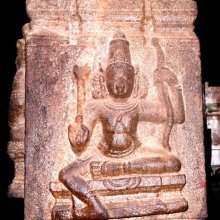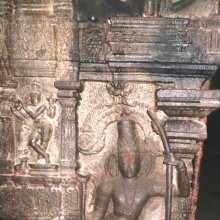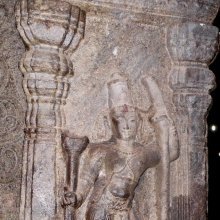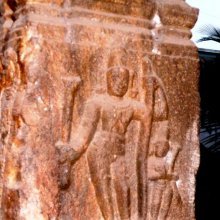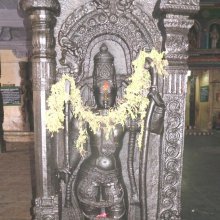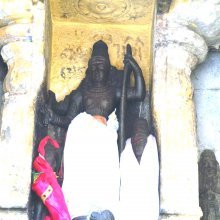Kodanda, Kodaṇḍa, Kodamda: 18 definitions
Introduction:
Kodanda means something in Hinduism, Sanskrit, Buddhism, Pali, Marathi, Jainism, Prakrit. If you want to know the exact meaning, history, etymology or English translation of this term then check out the descriptions on this page. Add your comment or reference to a book if you want to contribute to this summary article.
Images (photo gallery)
In Hinduism
Shaktism (Shakta philosophy)
Source: Google Books: ManthanabhairavatantramKodaṇḍa (कोदण्ड) refers to the “eyebrows”, according to the Ṣaṭsāhasrasaṃhitā, an expansion of the Kubjikāmatatantra: the earliest popular and most authoritative Tantra of the Kubjikā cult.—The Ṣaṭsāhasrasaṃhitā supplies a brief description of the Yogic practice by means of which the Accomplishment of Speech, that stimulates the operation of the Command, develops:—“One should meditate on the light that is within the Cavity of Brahmā (between) the eyebrows (kodaṇḍa). [...] Having meditated on it, one conquers Speech. [...] The Command functions by his seeing and looking (at the Divine Light). The Accomplishment of Speech, which brings about the immediate possession of men, comes about (spontaneously in this way). It is both speech in Sanskrit and the vulgate. It is the understanding of the wisdom of the scripture. It is attained if one is intent on practice”

Shakta (शाक्त, śākta) or Shaktism (śāktism) represents a tradition of Hinduism where the Goddess (Devi) is revered and worshipped. Shakta literature includes a range of scriptures, including various Agamas and Tantras, although its roots may be traced back to the Vedas.
General definition (in Hinduism)
Source: Wisdom Library: HinduismSanskrit for 'bow'.
Languages of India and abroad
Pali-English dictionary
Source: BuddhaSasana: Concise Pali-English Dictionarykodaṇḍa : (nt.) a bow.
Source: Sutta: The Pali Text Society's Pali-English DictionaryKodaṇḍa, (nt.) (cp. Sk. kodaṇḍa) a cross-bow M. I, 429 (opp. to cāpa); Miln. 351 (dhanu and k°). °ka same J. IV, 433 (explained by dhanu). (Page 228)

Pali is the language of the Tipiṭaka, which is the sacred canon of Theravāda Buddhism and contains much of the Buddha’s speech. Closeley related to Sanskrit, both languages are used interchangeably between religions.
Marathi-English dictionary
Source: DDSA: The Molesworth Marathi and English Dictionarykōdaṇḍa (कोदंड).—n (S) A bow. 2 fig. or bhrūkōdaṇḍa An eyebrow. 3 fig. (From a tale of Rawan̤'s being overpowered and nearly strangled by the bow of Ram, which he had raised.) A heavy calamity or trouble. See rāmakōdaṇḍa.
--- OR ---
kōdaṇḍa (कोदंड).—a P Rough, rude, violent, overbearing.
Source: DDSA: The Aryabhusan school dictionary, Marathi-Englishkōdaṇḍa (कोदंड).—n A bow.
Marathi is an Indo-European language having over 70 million native speakers people in (predominantly) Maharashtra India. Marathi, like many other Indo-Aryan languages, evolved from early forms of Prakrit, which itself is a subset of Sanskrit, one of the most ancient languages of the world.
Sanskrit dictionary
Source: DDSA: The practical Sanskrit-English dictionaryKodaṇḍa (कोदण्ड).—A bow; रे कन्दर्प करं कदर्थयसि किं कोदण्डटङ्कारवैः (re kandarpa karaṃ kadarthayasi kiṃ kodaṇḍaṭaṅkāravaiḥ) Bhartṛhari 3.1; कोदण्डपाणिनिनदत्प्रतिरोधकानाम् (kodaṇḍapāṇininadatpratirodhakānām) M.5.1.
-ṇḍaḥ 1 An eye-brow.
2) Name of a country.
Derivable forms: kodaṇḍaḥ (कोदण्डः), kodaṇḍam (कोदण्डम्).
Source: Cologne Digital Sanskrit Dictionaries: Shabda-Sagara Sanskrit-English DictionaryKodaṇḍa (कोदण्ड).—mn.
(-ṇḍaḥ-ṇḍaṃ) A bow. m.
(-ṇḍaḥ) 1. An eyebrow. 2. The name of a country. E. kuṇ to sound, aṇḍa Unadi affix, &c. dana inserted; the final radical consonant is rejected; otherwise, kud to speak false, aṇḍac aff.
Source: Cologne Digital Sanskrit Dictionaries: Benfey Sanskrit-English DictionaryKodaṇḍa (कोदण्ड).—[ko-daṇḍa] (ko = kas, nom. sing. of kim; cf. ku-), n. (and m.), A bow, [Bhartṛhari, (ed. Bohlen.)] 1, 97.
Source: Cologne Digital Sanskrit Dictionaries: Cappeller Sanskrit-English DictionaryKodaṇḍa (कोदण्ड).—[substantive] a bow.
Source: Cologne Digital Sanskrit Dictionaries: Monier-Williams Sanskrit-English Dictionary1) Kodaṇḍa (कोदण्ड):—[=ko-daṇḍa] mn. [cf. Lexicographers, esp. such as amarasiṃha, halāyudha, hemacandra, etc.] a bow, [Mālavikāgnimitra; Bhartṛhari; Bhāgavata-purāṇa; Kathāsaritsāgara xxii, 92; Rājataraṅgiṇī v, 104; Hitopadeśa]
2) [v.s. ...] m. an eyebrow (shaped like a bow), [cf. Lexicographers, esp. such as amarasiṃha, halāyudha, hemacandra, etc.]
3) [v.s. ...] a creeping plant, [cf. Lexicographers, esp. such as amarasiṃha, halāyudha, hemacandra, etc.]
4) [v.s. ...] Name of a country, [cf. Lexicographers, esp. such as amarasiṃha, halāyudha, hemacandra, etc.]
Source: Cologne Digital Sanskrit Dictionaries: Yates Sanskrit-English DictionaryKodaṇḍa (कोदण्ड):—[(ṇḍaḥ-ṇḍaṃ)] 1. m. n. A bow. m. Eye-brow; name of a country.
Source: DDSA: Paia-sadda-mahannavo; a comprehensive Prakrit Hindi dictionary (S)Kodaṇḍa (कोदण्ड) in the Sanskrit language is related to the Prakrit word: Kodaṃḍa.
[Sanskrit to German]
Sanskrit, also spelled संस्कृतम् (saṃskṛtam), is an ancient language of India commonly seen as the grandmother of the Indo-European language family (even English!). Closely allied with Prakrit and Pali, Sanskrit is more exhaustive in both grammar and terms and has the most extensive collection of literature in the world, greatly surpassing its sister-languages Greek and Latin.
Prakrit-English dictionary
Source: DDSA: Paia-sadda-mahannavo; a comprehensive Prakrit Hindi dictionaryKodaṃḍa (कोदंड) in the Prakrit language is related to the Sanskrit word: Kodaṇḍa.
Prakrit is an ancient language closely associated with both Pali and Sanskrit. Jain literature is often composed in this language or sub-dialects, such as the Agamas and their commentaries which are written in Ardhamagadhi and Maharashtri Prakrit. The earliest extant texts can be dated to as early as the 4th century BCE although core portions might be older.
Kannada-English dictionary
Source: Alar: Kannada-English corpusKōdaṃḍa (ಕೋದಂಡ):—
1) [noun] (in schools of yester years) a punishment of tying the hands of a student with a rope and pulling it up.
2) [noun] the rope used for this purpose.
3) [noun] ಕೋದಂಡಕ್ಕೇರಿಸು [kodamdakkerisu] kōdaṇḍakkērisu to tie (the hands of a student) with a rope and pull the rope upward; ಕೋದಂಡಕ್ಕೆ ಹಾಕು [kodamdakke haku] kōdaṇḍakke hāku = ಕೋದಂಡಕ್ಕೇರಿಸು [kodamdakkerisu].
--- OR ---
Kōdaṃḍa (ಕೋದಂಡ):—
1) [noun] a device for shooting arrows with a taut string joining the ends of a curved piece of wood etc; a bow.
2) [noun] the line of hair growing on the ridge above the eye socket; the eye-brow.
Kannada is a Dravidian language (as opposed to the Indo-European language family) mainly spoken in the southwestern region of India.
Nepali dictionary
Source: unoes: Nepali-English DictionaryKodaṇḍa (कोदण्ड):—n. a bow;
Nepali is the primary language of the Nepalese people counting almost 20 million native speakers. The country of Nepal is situated in the Himalaya mountain range to the north of India.
See also (Relevant definitions)
Partial matches: Danda, Ko, Tanta.
Starts with: Kodamdagama, Kodamdakamda, Kodamdapamdita, Kodamdapartha, Kodamdarudra, Kodandamandana, Kodandarama, Kodandayantra, Kotantam, Kotantapani, Kotantaveli.
Ends with: Ikshukodamda, Kusumakodamda, Ramakodanda, Vajrakodanda, Vilasakodanda.
Full-text (+1): Kodandin, Tamkarita, Kodand, Jhamkarita, Vilasacapa, Vilasakodanda, Vilasadhanvan, Vilasabana, Kodandayantra, Kotantapani, Kotantam, Capa, Kadarthayati, Paraniya, Siddha-bat, Ko, Lagula, Dhar, Vajrakodanda, Darshana.
Relevant text
Search found 17 books and stories containing Kodanda, Kodaṇḍa, Kodamda, Kōdaṇḍa, Ko-danda, Ko-daṇḍa, Kodaṃḍa, Kōdaṃḍa; (plurals include: Kodandas, Kodaṇḍas, Kodamdas, Kōdaṇḍas, dandas, daṇḍas, Kodaṃḍas, Kōdaṃḍas). You can also click to the full overview containing English textual excerpts. Below are direct links for the most relevant articles:
Garga Samhita (English) (by Danavir Goswami)
Verse 6.7.14 < [Chapter 7 - The Marriage of Śrī Rukmiṇī]
Verse 5.6.24 < [Chapter 6 - Seeing Śrī Mathurā]
Verses 5.6.35-36 < [Chapter 6 - Seeing Śrī Mathurā]
Sculpture at its Best < [May-June, 1929]
English in India < [October 1964]
Mother Teresa < [July – September, 1993]
Chaitanya Bhagavata (by Bhumipati Dāsa)
Verse 3.4.322 < [Chapter 4 - Descriptions of Śrī Acyutānanda’s Pastimes and the Worship of Śrī Mādhavendra]
Sahitya-kaumudi by Baladeva Vidyabhushana (by Gaurapada Dāsa)
Text 8.5 < [Chapter 8 - Literary Qualities]
Text 10.84 < [Chapter 10 - Ornaments of Meaning]
Text 10.102 < [Chapter 10 - Ornaments of Meaning]
Brihad Bhagavatamrita (commentary) (by Śrī Śrīmad Bhaktivedānta Nārāyana Gosvāmī Mahārāja)
Verse 2.1.75 < [Chapter 1 - Vairāgya (renunciation)]
Early Chola Temples (by S. R. Balasubrahmanyam)
Temples in Tondamanad (34th year) < [Chapter X - Historical Survey]
